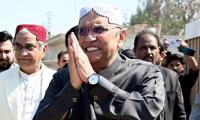KARACHI: The State Bank of Pakistan on Thursday warned against the risks of financial fragility in the current second half of 2018 (H2CY18), mainly stemming from mounting external and fiscal pressures on the economy.
“The outlook for the banking sector remains stable supported by an upswing in economic activity, improvement in investor confidence and the political stability,” the central bank said in a report.
However, the state bank added that banking sector’s profitability would depend upon interest rate dynamics, demand for advances, banks’ investment strategy, and movement in foreign exchange and capital markets.
“In H2CY18, the macro-financial conditions are expected to remain tight,” said the SBP’s half-yearly performance of the banking sector,” the results of the second wave of SBP Systemic Risk Survey suggested.
It also added that external sector pressures, fiscal sector vulnerabilities, growing domestic inflation and volatile commodity markets could potentially weaken financial stability over the coming six months.
As per the report, the SBP remains upbeat about the appetite for bank loans due to seasonal factors, capacity enhancement, and boost in investors’ confidence after peaceful political transition.
Nevertheless, at the same time, the central bank feared that the difficult financial conditions in response to monetary tightening [necessary to curb demand and trim inflation] may compel private borrowers to obtain new loans in July-December period of this year.
“Growing inflationary pressures due to rising aggregate demand and expected bullish trend in global oil prices may translate into higher demand for working capital financing needs. However, increase in SBP policy rate by 100 basis points in July 2018 and rising global trade disputes, could moderate the demand for advances,” it said. Total assets of the banking sector rose 9.7 percent to Rs19.197 trillion in the first half of this year.
The SBP’s analysts believe banks’ investment is likely to remain concentrated in short-term government securities given the interest rate expectations. Moreover, it said, higher projected reliance on banks’ borrowing by government—as outlined in the fiscal budget for 2018-19—could stimulate banks’ investments in government securities.
However, if the governments’ announced measures result into fiscal consolidation, then budgetary borrowing from banks could reduce. Deposit inflow will depend upon banks business strategy and savers preferences that are driven by macroeconomic conditions (external account pressures, monetary policy stance, and return on alternate assets etc.).
“The rising Minimum Saving Rate (MSR) could potentially boost saving deposits, however,” it added.
Bank’s health continues to improve, as progress has been made in reducing non-performing loans, while a majority of banks are trying to increasing capital and restoring profitability, the SBP report said.
It added that banks were likely to maintain adequate solvency profile given the expectations of rise in earnings and rising regulatory requirements under Basel-III and the D-SIBs framework.
“Asset quality is likely to improve as the expected increase in advances and the seasonal fall in NPLs related to agriculture financing materialises,” it mentioned.
The central bank, however said, beyond these improvements, the rise in SBP’s policy rate may impact the borrowers’ repayment capacity.
The report also warned that expected increase in advances could lead to higher credit risk weighted assets that may moderate the capital adequacy ratio a bit.
Meanwhile, the SBP, in a statement, said banking sector has performed reasonably well. “The asset base of the banking sector has expanded by 4.7 percent during the first six months of 2018,” the SBP said.
It added that encouragingly, advances to the private sector had been the key contributor in the asset growth with sugar, energy, and cement sectors along with individuals (i.e. sole proprietorships) being the key borrowers. “Deposits have observed slight deceleration but remained the mainstay of funds for the banks,” the central bank said.
A Nestlé office seen in this undated image.—The News/File LAHORE: Nestle Pakistan has released its 2023 Creating...
An undated image of a gold set displayed at a jewellery store. — AFP/FileKARACHI: Gold prices increased by Rs2,500...
Institute of Chartered Accountants of Pakistan building seen in this undated photo. — Business Recorder/FileKARACHI:...
A representational image of the SECP logo. — X/@SECPakistan/FileISLAMABAD: The Securities and Exchange Commission of...
A representational image showing farmers harvesting wheat crops in a field. — AFP/FileISLAMABAD: The Federation of...
A foreign currency dealer counts US dollar notes at a currency market in Karachi on July 19, 2022. — AFPNew York:...







